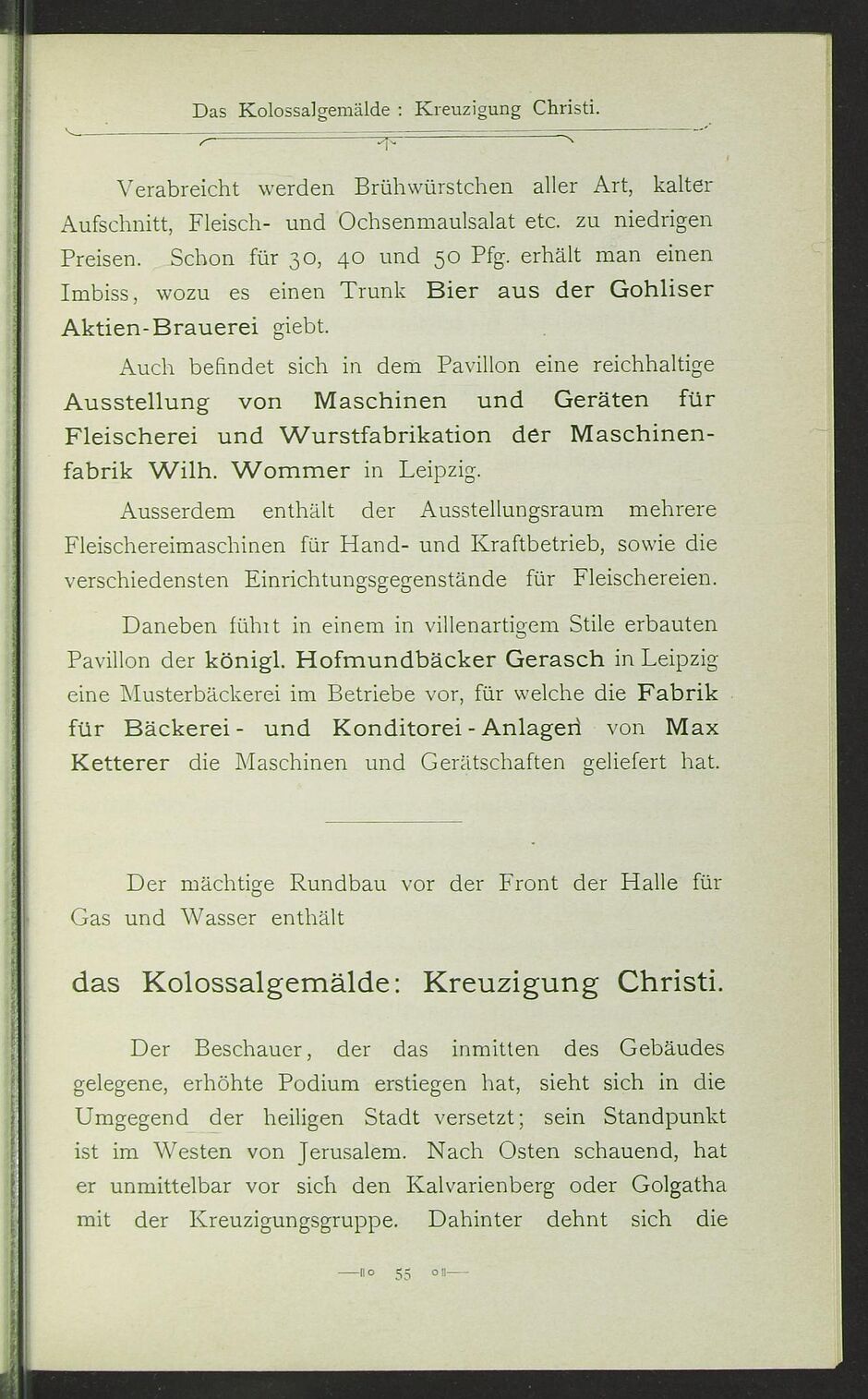
Der sogenannte Klingersaal in der Kunsthalle war eine der Attraktionen der STIGA. In ihm ausgestellt wurden u. a. Max Klingers neuestes Werk „Christus im Olymp“ und das von 1890 stammende Panorama „Die Kreuzigung Christi“ – eines der ersten Monumentalgemälde Klingers.
„Der Beschauer der das inmitten des Gebäudes gelegene, erhöhte Podium erstiegen hat, sieht sich in die Umgegend der heiligen Stadt versetzt; sein Standpunkt ist im Westen von Jerusalem. Nach Osten schauend, hat er unmittelbar vor sich den Kalvarienberg oder Golgatha mit der Kreuzigungsgruppe. Dahinter dehnt sich die Stadt Jerusalem in ihrer ganzen Pracht und Schönheit aus, überragt von den Höhen des Oelberges. Ganz im Hintergrunde sieht man jenseits des Toten Meeres die Moabiterberge. Die Künstler, die Münchener Maler C. Frosch, Jos. Krieger und W. Leigh, machten die Studien zu dem Werke in Jerusalem an Ort und Stelle. Der Eintrittspreis beträgt für die Person 50 Pfg“ (Quelle: Offizieller Führer der STIGA 1897).
Es misst 251 mal 465 Zentimeter und war nicht für den sakralen Raum bestimmt.
Mit diesem Panorama wollte Klinger, zu der Zeit 33 Jahre alt und gefeierter Grafiker, seinen Status als Maler manifestieren. Dabei bediente er sich thematisch dem wohl ältesten und wichtigsten Thema der Kunstgeschichte. Die erste Präsentation der „Kreuzigung Christi“ war eine Ausstellung 1891 in München, wo es für große Empörung sorgte. Zum einen wegen der vollkommen nackt dargestellten Personen, einschließlich Jesus ohne Lendentuch – wenn auch historisch korrekt. Zum anderen wegen der im Mittelpunkt des Gemäldes stehenden Maria Magdalena – einer Frau.
Bis heute werden die Motive und Darstellungen vor allem unter Theolog:innen viel diskutiert.
Auf der STIGA 1897 galt „Die Kreuzigung Christi“ als wichtige Attraktion. Für dieses und sein Gemälde „Christus im Olymp“ wurde Max Klinger mit einer goldenen Medaille ausgezeichnet.
English
The so-called Klinger Hall in the Art Hall was one of the attractions of STIGA. In it were exhibited, among others, Max Klinger's latest work "Christ in Olympus" and the panorama "The Crucifixion of Christ" from 1890 - one of the first monumental paintings by Klinger.
"The viewer who has climbed the elevated podium in the middle of the building sees himself transported to the surroundings of the holy city; his point of view is to the west of Jerusalem. Looking to the east, he has directly in front of him Calvary or Golgotha with the crucifixion group. Behind it stretches the city of Jerusalem in all its splendor and beauty, surmounted by the heights of Mount Oel. In the background, beyond the Dead Sea, one sees the Moabite Mountains. The artists, the Munich painters C. Frosch, Jos. Krieger and W. Leigh, made the studies for the work in Jerusalem on the spot. The entrance fee for the person is 50 Pfg" (source: Official Guide of STIGA 1897).
It measures 251 by 465 centimeters and was not intended for sacred space.
With this panorama Klinger, at the time 33 years old and a celebrated graphic artist, wanted to manifest his status as a painter. In doing so, he thematically used what is probably the oldest and most important subject in the history of art. The first presentation of the "Crucifixion of Christ" was an exhibition in Munich in 1891, where it caused great outrage. On the one hand, because of the completely depicted naked persons, including Jesus without loincloth - although historically correct. Secondly, because of Maria Magdalena - a woman - standing in the center of the work.
To this day, the motifs and depictions are much discussed, especially among theologians.
At the STIGA 1897 "The Crucifixion of Christ" was considered an important attraction. For this and his painting "Christ in Olympus" Max Klinger was awarded a gold medal.
Quelle Bild: Die Kreuzigung Christi_1890
